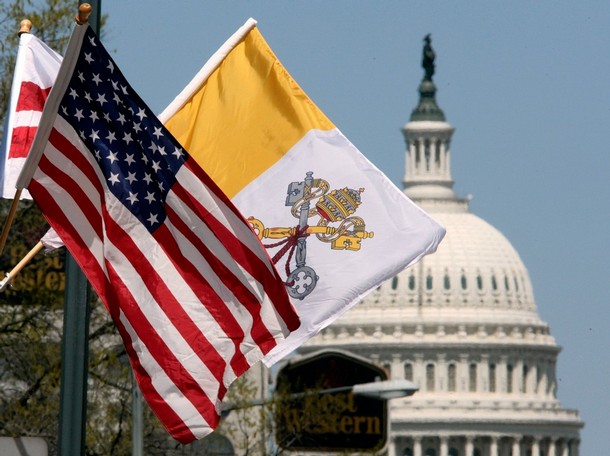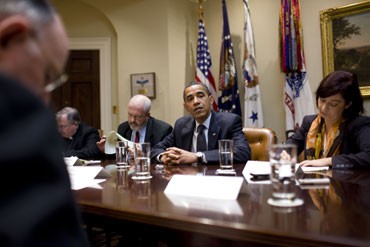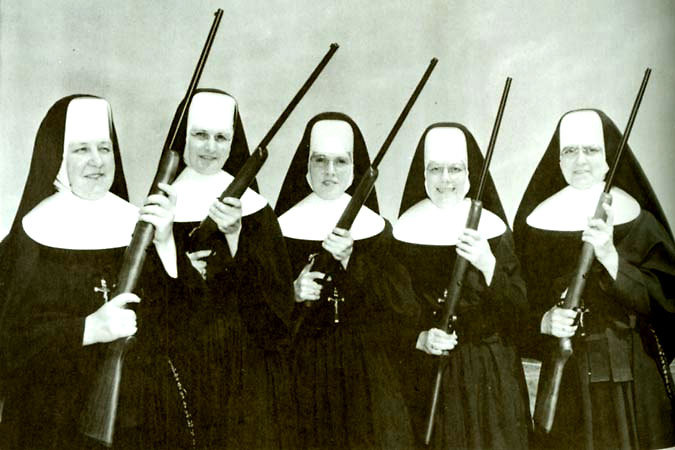 That is the title of Michael Sean Winters’ fascinating essay at NCR on Cardinal Gibbons’ 1887 sermon delivered in Rome at Santa Maria in Trastevere (my old neighborhood church, alas). The ocassion was the consistory elevating Gibbons, of Baltimore, to cardinal, just the second American so honored. This was the era of the Americanist debates as to whether one could be a good Catholic and a good American (plus ca change), or really whether American Catholics were changing Roman Catholicism into an American Catholicism. Church leaders rejected this, and Gibbons delivered a homily at his new titular church “defending the American constitutional model of church-state relations.”
That is the title of Michael Sean Winters’ fascinating essay at NCR on Cardinal Gibbons’ 1887 sermon delivered in Rome at Santa Maria in Trastevere (my old neighborhood church, alas). The ocassion was the consistory elevating Gibbons, of Baltimore, to cardinal, just the second American so honored. This was the era of the Americanist debates as to whether one could be a good Catholic and a good American (plus ca change), or really whether American Catholics were changing Roman Catholicism into an American Catholicism. Church leaders rejected this, and Gibbons delivered a homily at his new titular church “defending the American constitutional model of church-state relations.”
“For myself, as a citizen of the United States, without closing my eyes to our defects as a nation, I proclaim, with a deep sense of pride and gratitude, and in this great capital of Christendom, that I belong to a country where the civil government holds over us the aegis of its protection without interfering in the legitimate exercise of our sublime mission as ministers of the Gospel of Jesus Christ,” the cardinal said. “But while we are acknowledged to have a free government, we do not perhaps receive due credit for possessing also a strong government. Yes, our nation is strong, and her strength lies, under Providence, in the majesty and supremacy of the law, in the loyalty of her citizens to that law, and in the affection of our people for their free institutions.”
Winters continues the story:
In 1887 in Rome, those were fighting words. His biographer, Msgr. John Tracy Ellis, wrote, “Gibbons’ address, with its strong emphasis upon the liberty of the church in the United States, had an importance and significance quite beyond the ordinary sermon of this kind.”
In late 19th-century Rome, virtually all politics was seen through the lens of the pope’s loss of his temporal sovereignty over the Papal States. With the memory of Pius VI and Pius VII imprisoned by Napoleon, the spiritual independence of the papacy was thought to be bound up with its temporal independence. Both were threatened by the rise of liberal democratic regimes in Europe, most especially in Italy, which had annexed most of the Papal States in 1860 and took over Rome itself in 1870. Camillo Benso di Cavour, the leader of the Risorgimento, had suppressed almost all the monasteries and convents in Piedmont and seemed bent on doing the same throughout a united Italy. Liberalism, for all its protestations of guaranteeing freedom, was decidedly anticlerical in Europe.
Pope Pius IX’s 1864 encyclical Quanta Cura, which included the promulgation of the Syllabus of Errors, began as a reply to a speech by Charles de Montalembert calling for the reconciliation of the church with democracy. Montalembert titled his speech “A Free Church in a Free State.” None could question the religious devotion of this noble Frenchman, but the pope saw nothing but ruin coming from the French Revolution and its progeny. Pope Leo XIII declared in his 1885 encyclical Immortale Dei that the church was not committed to any particular form of government and that she could work with all, but he also went on to condemn freedom of religion and freedom of the press as threats to civil society and true religion.
This, then, was the context for Gibbons’ heroic address at Santa Maria in Trastevere…
Read on…and Happy Fourth of July!

